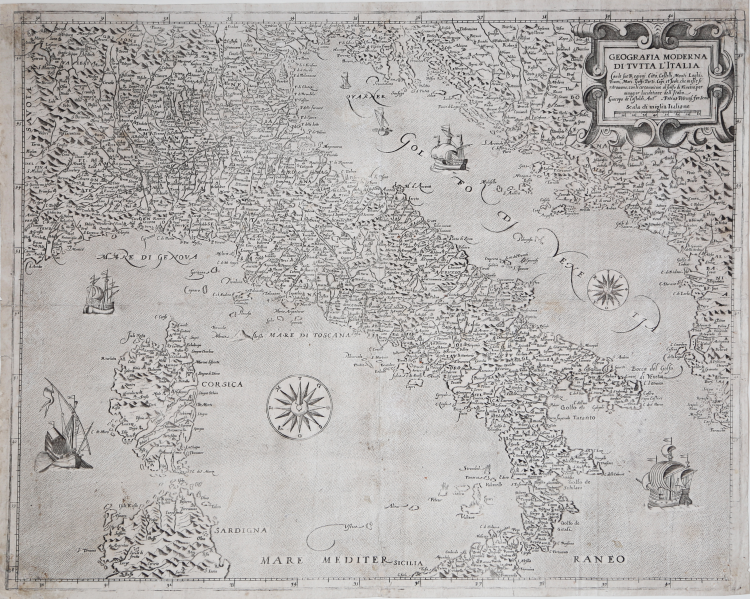




| Reference: | S50250 |
| Author | Matteo FLORIMI |
| Year: | 1590 ca. |
| Zone: | Italy |
| Printed: | Siene |
| Measures: | 500 x 398 mm |



| Reference: | S50250 |
| Author | Matteo FLORIMI |
| Year: | 1590 ca. |
| Zone: | Italy |
| Printed: | Siene |
| Measures: | 500 x 398 mm |
An extremely rare map of the Italian Peninsula published in Siena by Matteo Florimi, here reprinted by Pietro Petrucci, as indicated by the imprint on the title block, which replaces Florimi's.
At the top right of the title block, the following is written:GEOGRAFIA MODERNA DI TUTTA L’ITALIA Con le sue Regioni. Città, Castelli, Monti, Laghi, Fiumi, Mari, Golfi Porti, Capi et Isole, che in esse si ritrovano con le circonvicine al Golfo di Venetia per maggior lucidatione dell’Italia. Giacopo de Castaldi Aut.re Petrus Petrucci for. Senis.
It is a derivation of Giacomo Gastaldi's map of 1561 and its subsequent derivations, as indicated in Bifolco/Ronca (2018): "Florimi's map, undated, derives from Gastaldi's model of 1561, although it is more likely that the Sienese copied the version made by Duchetti, of whom Florimi was a pupil during his brief stay in Rome. The date (1590) is taken from that provided by much of the literature. Lago (2002) even suggests that the map was printed in 1574. If we analyse Florimi's cartographic production, a dating around 1600 would seem more appropriate. The plate was reprinted by Pietro Petrucci, another Sienese publisher who purchased the Matteo Florimi's chalcographic heritage” (cfr. Cartografia e Topografia italiana del XVI secolo, p. 1844).
Matteo Florimi (Polistena c. 1540 - Siena 1613) was a publisher and merchant of books and prints. Of Calabrian origin, he settled in Siena in 1581, with a store “in Banchi”. Matteo Florimi's chalcographic activity was several times joined by master engravers such as Cornelis Galle, Arnoldo Arnoldi, Pieter de Iode, Jan Sadeler and artists such as Francesco Vanni, Ventura Salimbeni and Alessandro Casolani, with whom the printer collaborated in the preparation of religious subjects. Florimi's cartographic activity produced prints of many cities and territories around the world, which were never drawn for him, but were manipulations of already existing reliefs, or of maps published by other printers. In the second half of the sixteenth century, Florimi was far-sighted in devoting himself to the production of bird's-eye views of cities as faithfully as possible. Florimi copied some maps by Antonio Lafreri, Claude Duchet, Abraham Ortelius. As far as map engraving work was concerned, in 1600, Matteo Florimi called the Flemish engraver Arnoldo degli Arnoldi to work in his workshop with the promise of greater compensation than that bestowed upon him by Giovanni Antonio Magini, with whom the artist was working. This offer by Florimi triggered the wrath of Magini, who, though not naming him, called him an "envious counterfeiter" for stealing such a skilled cartographer from him. The collaboration between Florimi and Arnoldi lasted only two years (1600-1602), but it was quite productive: together they printed the Stato di Siena, la Choronografia Tusciae, la Nuova descrittione della Lombardia, l’Europa, l’America and the Descrittione Universale della Terra.
Pietro Petrucci, a publisher and printer active in Siena between the late 16th and early 17th centuries, inherited part of Matteo Florimi's copperplates, which he reprinted under his own name. He also oversaw the reprint of several plates engraved by Arnoldo de Arnoldi, including the 12-sheet world map.
Etching and engraving, printed on contemporary laid paper with a "circle with trefoil and the letters DM" watermark, with thin margins, minimal, perfectly executed corner restorations, otherwise in excellent condition.
Extremely rare map. According to Cartografia e Topografia italiana del XVI secolo, only two institutional copies of Florimi's edition and three of this Petrucci edition are listed.
Bibliografia
Cartografia e Topografia italiana del XVI secolo, pp. 1844-45, n. 925, II/II; cfr. Almagià (1929): p. 27, Almagià (1948): p. 32; F; Arrigoni-Bertarelli (1930): n. 2951; Bifolco-Ronca (2014): n. 17; Borri (1999): pp. 56-57, n. 56; Borri (2010): pp. 75-76, nn. 59-59, figg. 76-77; Van der Heijden (1993): n. 10; cfr. Karrow (1993): n. 30/90.7; Lago (1994): p. 248, n. 95; Lago (2002): p. 288, fig.287.
Matteo FLORIMI (Polistena 1540 circa - Siena 1613)
|
Print and book dealer and publisher, from Calabria. He came to Siena c.1581.Shop in Banchi. The first evidence of his independent activity is of 1589. In 1591 he published a book of patterns for lace, The Fiori di ricami, in Venice, and in 1593 a second edition in Siena.
In 1597 he published the Life of St Catherine, engraved by De Jode after Vanni, and the Passion of Christ by De Jode after Andrea Boscoli. He published a large number of maps and figural prints are mostly religious. He employed engravers of the calibre of Agostino Carracci, Cornelis Galle, Pieter de Jode Villamena and Thomassin, among others.
He commissioned drawings from Andrea Boscoli. He had a particularly close relationship with Vanni. In the years 1605-8, Florimi received financial support from Ottavio Cinuzzi.
|
Matteo FLORIMI (Polistena 1540 circa - Siena 1613)
|
Print and book dealer and publisher, from Calabria. He came to Siena c.1581.Shop in Banchi. The first evidence of his independent activity is of 1589. In 1591 he published a book of patterns for lace, The Fiori di ricami, in Venice, and in 1593 a second edition in Siena.
In 1597 he published the Life of St Catherine, engraved by De Jode after Vanni, and the Passion of Christ by De Jode after Andrea Boscoli. He published a large number of maps and figural prints are mostly religious. He employed engravers of the calibre of Agostino Carracci, Cornelis Galle, Pieter de Jode Villamena and Thomassin, among others.
He commissioned drawings from Andrea Boscoli. He had a particularly close relationship with Vanni. In the years 1605-8, Florimi received financial support from Ottavio Cinuzzi.
|